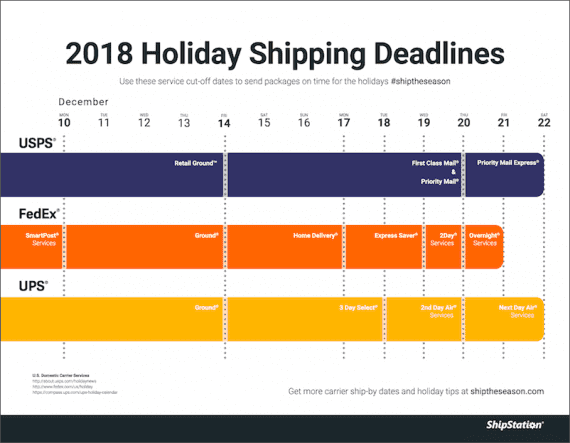Customers expect delivery. For online stores that sell tangible products, order fulfillment is arguably the single most essential task. It is the culmination of marketing, web development, and customer service. For retail ecommerce businesses, providing a customer with a product is the mission. And the worst possible time to mess up that mission could be during the peak holiday sales season.
In 2017, total U.S. online retail sales reached $108.15 billion in the last two months of the year, according to an Adobe Digital Insights report.

Drawing data from more than several thousand ecommerce stores, Adobe estimated that total U.S. online holiday sales were more than $108 billion.
Some retailers could do a third or more of their annual sales in just a few days. The opportunities, therefore, are great, but so is the opportunity for shipping error.
Consider what is at stake. Online stores have a couple of opportunities for holiday sales. First, there is the obvious chance to make a sale and earn profit immediately. But there is also an opportunity to make a sale in the future. Happy customers may come back in February, March, April, or every month next year. Repeat customers tend to have a much lower cost of acquisition than do new ones. Thus, retaining customers from the holiday season can help profits and growth.
A shipping failure, however, can scuttle both opportunities. If a package is lost, the retailer may have to replace the item and pay extra shipping. What’s more, the shipping glitch may have soured the customer, destroying the chance for repeat sales.
While it can be difficult to anticipate and prepare for every shipping and fulfillment problem, what follows are six common ecommerce shipping mistakes your business should avoid.
1. Not Communicating Carrier Cutoffs
The vast majority of holiday sales have a shipping deadline. Orders need to arrive on or before December 24. Your customers expect orders to arrive by this deadline unless your company sets a proper expectation.

Using carrier information, ShipStation has assembled holiday cutoff dates for the three leading package carriers in the United States.
As an example, for most major package carriers in the United States, December 14, 2018, is the cutoff for ground shipments to arrive by Christmas Eve. This date will differ a little depending on where your warehouse is located and the order destination. But in general, ground orders need to be placed about 10 days ahead of the holiday.
If you don’t communicate this fact to your shoppers, you could have problems.
Imagine an order that comes in on December 20. It has the gift wrap option selected. The customer leaves a gift message, “Merry Christmas, Grandma loves you.” And the customer selected free ground shipping. If your business didn’t communicate carrier cutoff dates, you may have to call the customer, let her know the gifts won’t arrive on time for Christmas, and, perhaps, lose the order.
2. Not Enough Help
Imagine that it takes your warehouse employees 10 minutes to pick, pack, label, and stack a typical order. That means that if you have four employees each working for eight hours a day, your business can ship about 192 orders per day at full capacity. That’s not bad — until you have 300 orders.
One of the greatest shipping challenges growing ecommerce businesses can face is being overwhelmed with orders during peak selling periods and then not being able to fulfill them all.
The key here is to plan. Will you need to hire temporary workers? Will you need to have longer shifts? Answer these questions before there are too many orders to handle.
3. Running Out of Packing Materials
You have hired temporary workers and are ready to scale. You have plenty of inventory. Then one of your packers comes up to you in the office and says, “We’re out of tape.”
If you plan on shipping 5,000 orders during the holiday rush, you are going to need 5,000 boxes or bags, 5,000 labels, and the appropriate amount of tape, bubble wrap, and other packing materials.
Here’s an example. One year, when I ran a small online toy store, we ran out of boxes on the ground shipping cutoff day. I had to buy cartons from the local U-Haul store for about $3 each.
4. Not Validating Delivery Addresses
“An incorrect zip code can not only throw off shipping but can land a package into an almost infinite state of limbo,” said Jonathan Poston, an experienced ecommerce executive who is currently the director of technical SEO for The Tombras Group.
“For example, one $2,000 package that was meant to go to an address in East [Tennessee] went to a post office near Raleigh [North Carolina]. Hours were spent on the phone…and weeks went by until, finally, someone solved it.”
To Poston’s point, a bad address can cause big problems. To avoid the issue, automatically verify delivery addresses. If an address looks weird, call the customer.

A bad address could get your shipment lost. Don’t let that happen. Image: Maarten van den Heuvel.
5. Incorrect Shipping Estimates
While verifying addresses, verify rates, too. To be sure, your ecommerce business should regularly audit its rate estimates, comparing what the customer was quoted or paid to the actual shipping cost.
If your ecommerce platform is getting shipping quotes from an application programming interface, ensure that it reflects your negotiated rates. If you’re using a rates table that you created, be certain it is accurate.
A bad shipping quote is double-edged. If the estimate is too low, you could have customers upgrade to one-day or two-day service, leaving your business to pay the difference. If the estimate is too high, that same shopper might abandon her shopping cart.
6. Spoiling the Christmas Surprise
“The biggest mistake ecommerce sites make around the holidays is shipping items in branded, logo-stamped boxes, or with an outwardly visible receipt,” explained Jim Milan from Auto Accessories Garage.
“If possible, switch to plain brown boxes during the holidays. After all, you may have spouses buying gifts for each other, and you don’t want the surprise to be spoiled if the would-be receiver sees the package before the giver has time to hide it.”